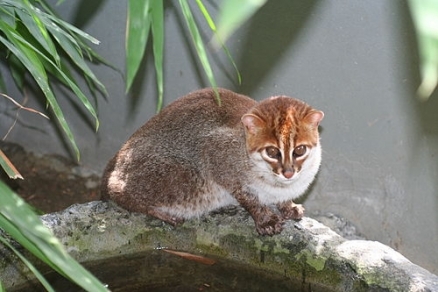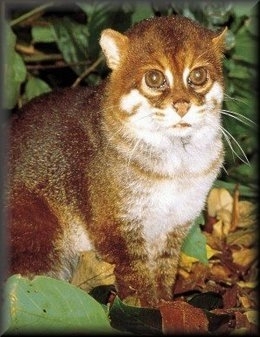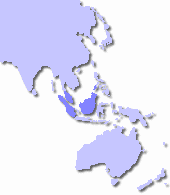Flat-headed cat (About the EoE)
Contents
Flat-headed cat
The Flat-headed cat (scientific name: Prionailurusplaniceps) is a rare and difficult to observe felid species; consequently there is a paucity of information regarding this carnivore. This cat’s chief dietary staple consists of fish, even at a more exaggerated level than the Fishing cat. It is a relatively small feline with a flat, broad head, small ears and large eyes. P. planiceps tends to live in riparian zones or proximate to other bodies of surface water; moreover, in captivity the species is known to enjoy hours in the water. Currently the Flat-headed cat’s largest threat is the expansion of oil palm plantations, such as in the forests of Borneo and peninsular Malaysia.
Physical Description
| Flat-headed cat. Source: International Society For Endangered Cats (ISEC) Canada |
|
Conservation Status |
|
Scientific Classification Kingdom: Animalia (Animals) |
The Flat-headed cat, as its name implies, has a flat, broad head, small ears that cling low on the sides of the skull, and a long, sloping snout. It has large, close-set eyes which provide maximal binocular vision, and the anterior upper pre-molars are larger and sharper relative to other felids. Two white stripes run from the sides of the nose towards the forehead. It has short squat legs, and a short but muscular tail. The fur is soft and thick and can range in coloration from a reddish brown to a copper brown. Generally the top of the head is slightly more red than the rest of the body. The underbody of the Flat-headed cat exhibits white and brown spots visible on the flanks and belly. The claws cannot be retracted, and the cat has an unusual pointed tooth design.
Flat-headed cats are about the size of a domestic cat, but are easily distinguished by their broad, flattened heads, small ears set well down on the sides of the skull, stumpy legs, and comparatively short tails. The width of the head seems to be increased by the large eyes.
The body is somewhat elongated, the effect of which is enhanced by the shortness of the legs. The paws are long and narrow, and the claw tips remain partially visible, as they do not retract entirely. The toes are more fully webbed than those of the closely related fishing cat (Prionailurus viverrina).
The nasals are short and narrow, and the long rostrum causes the teeth to be aligned in parallel rows. All teeth are sharp, and the anterior upper premolar is larger and better developed than in any other cat. It has two roots, and the cusps extend to the level of the carnassials. These modifications to the jaws probably aid in catching and holding fish, and are common in piscivores. All the body and limb modifications are consistent with those expected of a semi-aquatic mammal.
Males are typically larger than females, and measure 42 to 50 centimeters (cm) long. Females are between 33 cm and 37 cm in length. The thickly-furred tails are approximately 15 cm to 20 cm long. Prionailurus planiceps stands about 30 cm in height and ranges in body mass from 1.5 to 3.0 kilograms, with the females usually near the lower end of that range.
Distribution and Habitat
The historical range of the Flat-headed cat is restricted to the islands of Borneo and Sumatra and the Malay Peninsula up to the Isthmus of Kra. This cat was declared extinct in 1985, and was not rediscovered until spotted in palm oil plantations in Malaysia. In 1995 the cat was also sighted in a national park on the Merang River in Southeast Sumatra. The biologists assigned to the park had not previously heard of the Flat-headed cat.
Habitat
Flat-headed cats apparently spend much of their time close to water. They are found in wetlands and in floodplains in the lowland tropical forests of Malaysia, such as the Borneo lowland forests ecoregion. Many reported sightings are near or on riverbanks, swampy areas, oxbow lakes and riverine forests. This species has not been reported at elevations greater than 700 meters
Food and Feeding Habits
The diet ofthe Flat-headed catappears to be primarily fish, supplemented by certain frog and shrimp species. P. planiceps is been known to consume fruit, and prey on rodents in the Malay palm oil plantations. They sometimes also take chickens. Flat-headed cats discovered on the Malay Peninsula were apparently feeding on the numerous rats on the plantations.
A kitten held in captivity eagerly fished at depths limited by the basin to 12 centimeters, well over its head. It often washed objects in a manner similar to a racoon. It pounced on a prey, snarl, then take it about two meters away from the place where it was offered. This latter behavior is thought to be so that fish and frogs could not easily escape back into the water once caught. The captive kitten eagerly consumed live frogs and fish, but showed no interest in young sparrows brought into the cage.
Reproduction and Behavior
Little is known about the reproductive and social behavior of the Flat-headed cat. Closely related cats (Fishing cats and Leopard cats) are thought to be mainly solitary. It is likely that Flat-headed cats resemble their relatives in this respect.
Flat-headed cats may resemble othe closely related cats in some reproductive parameters. The closely related Fishing cat (Prionailurus viverrina) has mating peaks in January and February. In India, Fishing cat births occur from March through May. Young become independent around ten months of age. In Leopard cats (Prionailurus bengalensis), a female who has lost a litter may produce another within five months. Young leopard cats can reach sexual maturity by eight months of age.
As in all mammals, the mother produces milk for her young. Although parental care has not been studied in this species, it is reasonable to assume that like most felids, the young are altricial, and that the mother cares for her young in some secluded nest or den until they are able to follow her on foraging trips. Young felids typically spend some time with their mother learning species-appropriate hunting behavior prior to the time they disperse.
One Flat-headed cat held in captivity lived up to age 14 years. No information is available on lifespan in the wild.
Threats
Although the exact status of this obscure, seldom-encountered cat is not fully understood, it may be especially vulnerable because of its apparent association with watercourses. Habitats along rivers are often the first to be exploited and encroached upon by humans as settlements and agriculture expand. Perhaps an even greater threat to the species is water pollution, particularly by oil, organochlorines (Halocarbon) and heavy metals associated with agricultural run-off and logging activities, contaminating the cat's preyThe depletion of fish stocks from overfishing is prevalent in many Asian wetland environments and is likely to be a significant threat. Speculations point to the most pressing threat being the expansion of oil palm plantations.
Conservation Status
Flat-headed cats are fully protected over most of the species range, with hunting and trade prohibited in the countries of Indonesia, Malaysia, Myanmar, and Thailand, and hunting regulated in Singapore. No legal protections are in place for flat-headed cats in Brunei (Ecoregions of Brunei). They have been classified as Vulnerable (VU) on the IUCN Red List 2006 and listed on Appendix I of CITES.
References
- Encyclopedia of Life. 2011. Prionailurus planiceps
- David Alderton. Wild Cats of the World. Blandford: United Kingdom, 1998.
- Animal Diversity Web: Prionailurus planiceps[1]
- Ronald Nowak. 2005. Walker’s Carnivores of the World. The Johns Hopkins University Press: Baltimore.



